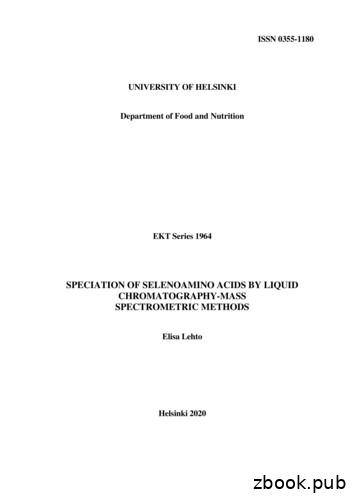High Performance Liquid Chromatography (HPLC)
HPLC Instrumentation
ElutionGradient elution in liquid chromatography is analogous totemperature programming in gas chromatography.Increased eluent strength is required to elute morestrongly retained solutes. RP-HPLC (increase organic, makemore non-polar). NP-HPLC (increase solvent to make morepolar)Gradient (gradual change) of eluent strength is used formany separations.Weakly retained solutes are eluted with solvent of loweluent strength. Second solvent is mixed with the first toelute the more strongly retained solutes. Gradual increasein eluent strength.
Partition Chromatography Normal-phase chromatography – uses a polar stationaryphase and a less polar solvent. Eluent strength is increased byadding a more polar solvent. No use of water!! Reversed-phasechromatography – uses a non-polarstationary phase. Eluent strength is increased by adding a lesspolar solvent. Water is often constituent of mobile phase.More waterPolarity: A B CMore organicTime
HPLC DetectorsMass LOD (g) concentration (mol/L) x inj. vol. (L) x FW (g/mol)
Detectors (UV/Vis or Fluorescence)Detector volumesmall like injectionvolume (10-20 μL)A εbCF α εbCPoΦWhat is the pathlength in thesecells?Fluorescencedetection is 90orelative toexcitation light
Detectors (Mass Spectrometry)Qualitative and Quantitative AnalysisNeed an interface that can take a continuous liquid eluent from LC andconvert analyte to ions in the gas for MS. Electrospray ionization is alsoan LC interface with MS.
Detectors (Electrochemical)Electrochemical detection (ECD) for HPLC is an extremely selective andsensitive detection technique that is applied in a number of analysessuch as the neurotransmitters dopamine, serotonin and noradrenalin. Incombination with the proper electronics, ECD has a linear dynamic rangeof more then 6 orders of magnitude. This means that concentrations canbe measured as low as 50 pmole/L and as high as 100 µmole/L or more.Columni (current) const x [Analyte]HPLC with amperometric detection.
Bonded Stationary Phases (Stable andControlled Chemistry)Normal-phase LCReversed-phase LCOrganochlorosilane coupling chemistry!!R group can be whatever one wants.
Particle Size Effect of Stationary PhaseSmaller particles,more efficientpacking, lower Aterm.Stronger solvent, greateraffinity for mobile phase(better solubility)
Effect of Particle Size of Stationary PhaseRemember:LN HN Smaller particle size, more efficient packing and improved plate numbers(efficiency of separation).
Reversed-Phase HPLCNotice the time!
Reversed-Phase HPLCEffect of organic solvent content (mixed with water)Forcing solutes to be moresoluble in stationary phase!!Decreasing organic solvent content
Gradient Elution in RP-HPLCMake the solutesmore soluble inmobile phase thanin stationaryphase!!!Solvent playsa key role inseparation!!!!Solution to the general elution problem.Nonpolar stationary phase. To elute solutes, must increase theeluent strength by adding organic solvent (mixed with water).
Quantitative Analysis of Naturally OccurringCannabinoidsThe analysis of natural cannabinoids is necessary not only because ofpotential medical uses for these compounds, but also in theregulation and quality control testing of products containing thesecompounds. To ensure the authenticity, quality, and amount of eachcannabinoid contained in the product, an LC–MS method wasdeveloped.This method showed certain medicinal oils or tinctures availableover the internet contained naturally occurring cannabinoids.CBG TypeTHC TypeWhat structural features make them separable by RP-HPLC? Could UV/Vis detectionbe used? Why?
RP-HPLC Natural CannabinoidsFigure 1: (a) Chromatogram of seven cannabinoids at 100 ng/mL in solvent. (b)Chromatogram of a commercially available tincture containing sevencannabinoids. Standard additions shown.
Detection Figures of Merit for DifferentCannabinoidsThis work demonstrates a rapid method for the detection of naturally occurringcannabinoids by using LC-MS. All seven cannabinoids were detected at levelsas low as 1 ng/mL (1 ppb or 1 pg on column) with a S/N of at least 20:1. Thismethod is useful for quantitating cannabinoids in raw or commercial products.Waters Scientific
Gradient elution in liquid chromatography is analogous to temperature programming in gas chromatography. Increased eluent strength is required to elute more strongly retained solutes. RP-HPLC (increase organic, make more non-polar). NP-HPLC (increase solvent to make more polar)
Jun 01, 2016 · THIAMINE HYDROCHLORIDE HPLC H ilic HPLC HPLC to Hilic HPLC Add HPLC ID test Remove pH test THIAMINE MONONITRATE HPLC Hilic HPLC HPLC to Hilic HPLC Add HPLC ID test Remove pH test NIACINAMIDE n/a n/a Remove Melting Range ADENINE HPLC to UPLC HPLC to UPLC n/a CALCIFEDIOL n/a add HPL
1. Theory of liquid chromatography. High performance liquid chromatography (HPLC) is a technique for separating analytes dissolved in a liquid, mobile phase by using their specific interaction with a stationary phase (chromatography column). Depending on the type of interaction of the sample molecules with both mobile and stationary phases,
2.3.1 Liquid chromatography (LC) 20 Size-exclusion chromatography (SEC) 20 Ion-exchange chromatography (IEC) 22 Reversed-phase chromatography (RP) 23 Reversed-phase ion pairing chromatography (RPIP) 24 2.3.2 Gas chromatography (GC) 25 2.3.3 Electrophoretic techniques 25 2.3.4 Isotope dilution analysis (IDA) 26 3 EXPERIMENTAL RESEARCH 27 Aims 27
Instrumentation – eluants, injectors, columns Modes of HPLC – Partition chromatography – Adsorption chromatography – Ion chromatography . 6 port rotary valve. Columns - usually stainless steel - can be PE
Lecture Overview Rate theory of HPLC van Deemter equation Principle of LC analysis - HPLC subclasses - Stationary phases in HPLC . Separation process in reversed-phase liquid chromatography . analyser Electrospray ionisation (ESI) source Two concentric steel tubes carry the liquid and nebulising gas. After nebulisation, additional gas
Chromatography 481 27.4.2 Partition (Liquid–Liquid) Chromatography 482 27.4.2.1 Introduction 482 27.4.2.2 Coated Supports 483 27.4.2.3 Bonded Supports 483 27.4.3 Ion-Exchange Chromatography 483 27.4.4 Size-Exclusion Chromatography 485 27.4.5 Affinity Chromatography 488 27.5 Analys
HPLC: historical overview The discovery of chromatography dates back to 1903, when Mikhail Tswett's research in the . immiscible liquid (chloroform) through a packed tube and hence developed liquid-liquid partition chromatography [4]. In a later experiment, the liquid mobile phase was replaced by a gas vapor, which
The Leaving Certificate Russian syllabus is set out in the context of a common syllabus framework for the teaching and examining of French, German, Spanish and Italian. The syllabus is "communicative" in the sense that it is based on the purposes to which learners are likely to want, need or expect to put the knowledge and skills they acquire in class to use, and in the sense that the .























